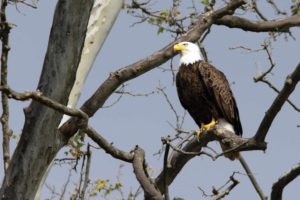Endangered Species Act Under Siege
By Elliot Brinkman
American wildlife is in a shocking state of decline, with as many as one-third of species at increased risk of extinction. Climate change, habitat destruction, and pollution threaten the survival of many species, but their ultimate peril may be found in the halls of Congress. Our nation’s landmark wildlife protection law—the Endangered Species Act—is currently under attack. In a time of extraordinary species decline, we need protections in place that allow wildlife to survive and thrive as our world, and climate, continue to rapidly change.

Over the past several weeks, we have seen numerous pieces of legislation, and more recently, a proposal from the White House, to eviscerate the Endangered Species Act—the very law credited with the recovery of the Bald Eagle and countless other species. The proposals come amid calls to “modernize” the Act; however, habitat and species protection appear to be an afterthought of such reform. Instead, these proposals weaken protections for species and the habitat they need to survive—something extractive industries have been trying do for years, with limited success. In the past, the Endangered Species Act has enjoyed broad, bipartisan support from those who recognize the need to preserve our natural heritage, but this renewed assault during a time when calls for deregulation are so prevalent is cause for concern.
There are many reasons to advocate for these protections, but the most convincing reason is that they actually work. In its 45-year history, the Endangered Species Act has been credited with saving from extinction 99% of the roughly 1,600 species it has protected. According to the Center for Biological Diversity, without these protections, “scientists estimate that at least 227 species would have likely gone extinct since the law’s passage in 1973.” Studies have also shown a 90 percent recovery rate for more than 100 species protected by the law, several of which can be found in Illinois.

The Endangered Species Act helps natural resource managers protect Illinois’ most rare and vulnerable species of mammals, birds, fish, reptiles, amphibians, mussels, and plants. It is no coincidence that you can now witness in Illinois the once rare and elusive bald eagle, or whooping crane; their recovery, in large part, is due to the Endangered Species Act. In a state where so much of our natural heritage has been lost and forgotten, it is important to preserve and nurture what we do have.
While it is important to acknowledge stories of recovery, we must also face the fact that we are living in a time of unprecedented species decline, affecting all classes of plants and animals. Climate change only compounds the issue, impacting species range, disease transmission, and habitat degradation. This hits close to home in the midst of declining numbers of pollinators and the potential addition of the Monarch Butterfly to the endangered species list. This is not a time to weaken protections, it’s a time to double-down on them.
So what do we need to reverse this crisis? We need adequate, common-sense protections for wildlife. We need agencies and institutions that are well-equipped to oversee the implementation of these protections. We need trained biologists in charge of protecting and preserving our natural resources. We need decision-makers who are willing to stand up to the outright attack on the most fundamental environmental protections we have. History has shown time and again that Americans want to protect endangered species; we need a Congress that carries out the will of the people.







